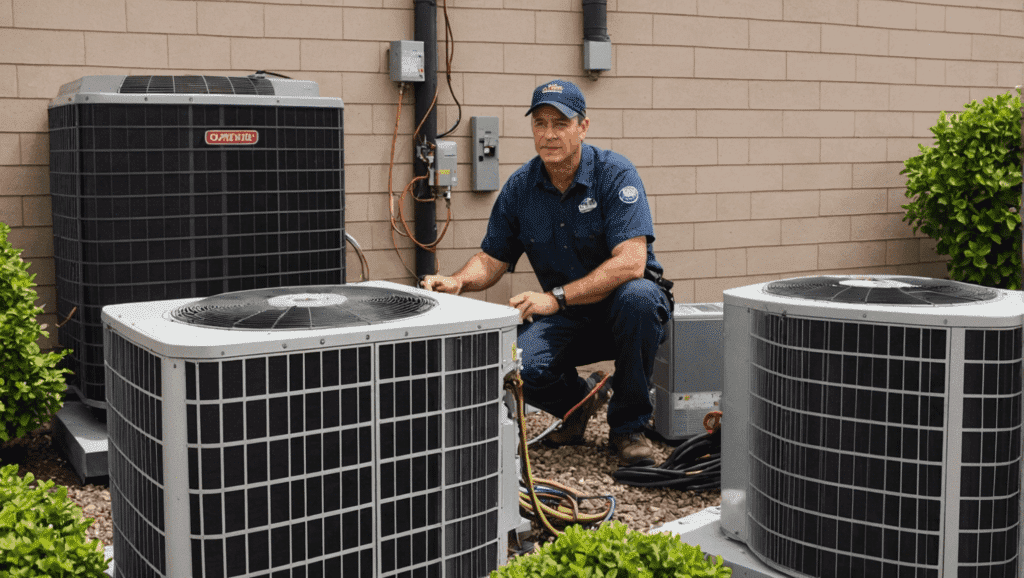More homeowners are discovering the benefits of an air conditioner without ducts as they seek efficient, flexible cooling solutions. These innovative systems provide targeted comfort without the energy losses associated with traditional ductwork. Whether you’re adding cooling to an older home, finishing a basement, or just looking to supplement your existing system, an air conditioner without ducts offers unique advantages that make it worth considering.
What Is an Air Conditioner Without Ducts?
An air conditioner without ducts, commonly called a ductless mini-split system, consists of an outdoor compressor/condenser and one or more indoor air-handling units. These components are connected by a conduit containing power cables, refrigerant tubing, and a condensate drain line. Unlike central air systems that push cooled air through ducts, an air conditioner without ducts delivers air directly into your living spaces.
According to the article AC Repair Solutions You Can Count On: Restoring Comfort in No Time!, ductless systems have become increasingly popular due to their energy efficiency and zoning capabilities. The absence of ducts eliminates the 25-30% energy loss typical of forced-air systems, making an air conditioner without ducts a smart choice for many homeowners.
How an Air Conditioner Without Ducts Works
Understanding the operation of an air conditioner without ducts helps explain its advantages:
The outdoor unit houses the compressor and condenser coil, just like a traditional AC. However, instead of connecting to ductwork, it links directly to compact indoor units through refrigerant lines.
Each indoor unit contains its own evaporator coil, fan, and air filter. Multiple indoor units can connect to a single outdoor unit, allowing for customized cooling in different zones.
A Temperature Probe HVAC system in each indoor unit monitors conditions and adjusts cooling output accordingly.
The system uses inverter technology to vary compressor speed rather than cycling completely on and off, improving efficiency and comfort.
Benefits of Choosing an Air Conditioner Without Ducts
Opting for an air conditioner without ducts provides several advantages over traditional systems:
Energy efficiency tops the list. Without duct losses, ductless systems can be 30-40% more efficient than conventional central air according to Energy Star estimates.
Zoned cooling allows different temperatures in different rooms. Each indoor unit operates independently, eliminating family thermostat battles.
Easy installation makes an air conditioner without ducts ideal for homes without existing ductwork. The small conduit requires only a 3-inch hole rather than extensive duct runs.
Improved air quality results from eliminating ducts that can harbor dust and allergens. Each indoor unit has its own Air Conditioner Filter Housing that’s easily accessible for cleaning.
Quiet operation comes from locating the noisiest components outside and using variable-speed technology that avoids sudden startups.
Common Applications for Air Conditioner Without Ducts
Several situations make an air conditioner without ducts particularly advantageous:
Older homes without existing ductwork can add cooling without expensive and invasive duct installation.
Room additions or finished basements often need supplemental cooling that an air conditioner without ducts can provide without taxing the main system.
Historic homes benefit from preserving architectural integrity while gaining modern comfort.
Multi-family housing allows individual temperature control for each unit without shared ductwork.
Hot spots in conventionally cooled homes can be addressed with targeted ductless units.
Potential Drawbacks of Air Conditioner Without Ducts
While an air conditioner without ducts offers many benefits, there are some considerations:
Higher upfront cost per ton of cooling compared to central systems, though operating savings often offset this.
Visible indoor units may not appeal to all homeowners aesthetically, though newer models offer sleek designs.
Limited whole-house dehumidification compared to properly sized central systems in humid climates.
Professional installation is crucial, as improper sizing or placement can lead to AC On But No Air Blowing issues or reduced efficiency.
Installation Considerations for Air Conditioner Without Ducts
Proper installation of an air conditioner without ducts requires careful planning:
Location selection for indoor units affects both performance and aesthetics. Units should be placed where airflow won’t be obstructed.
Outdoor unit placement considers noise, service access, and distance from indoor units (typically within 50 feet).
Refrigerant line routing must maintain proper pitch and insulation to prevent Overflow Switch activations or efficiency loss.
Electrical requirements vary by system size but often need dedicated circuits.
Professional sizing calculations ensure adequate capacity without oversizing that could cause short-cycling.
Maintaining Your Air Conditioner Without Ducts
While an air conditioner without ducts requires less maintenance than central systems, some care is essential:
Regular filter cleaning (monthly during cooling season) keeps airflow optimal and maintains efficiency.
Annual professional AC Maintenance should include checking refrigerant charge, cleaning coils, and inspecting electrical components.
Outdoor unit clearance (at least 2 feet) ensures proper airflow and prevents debris buildup.
Condensate drain inspection prevents clogs that could trigger safety switches or cause water damage.
Troubleshooting Common Air Conditioner Without Ducts Issues
Even well-maintained systems can develop problems:
If an indoor unit shows AC On But No Air Blowing, check for power issues, frozen coils, or a tripped safety switch.
Uneven cooling between zones may indicate incorrect sizing or refrigerant imbalances needing professional AC Repair Service.
Water leakage typically points to clogged drains or improper unit leveling.
Reduced cooling capacity often stems from dirty filters or low refrigerant charge.
Energy Efficiency Features of Modern Air Conditioner Without Ducts
Today’s air conditioner without ducts models incorporate advanced technologies:
Inverter-driven compressors adjust speed continuously rather than cycling on/off, improving efficiency and comfort.
Smart sensors detect room conditions and adjust output accordingly, similar to advanced Temperature Probe HVAC systems.
Wi-Fi connectivity allows remote control and monitoring through smartphone apps.
Heat pump capabilities provide both heating and cooling from the same unit in many models.
Comparing Air Conditioner Without Ducts to Other Options
Understanding how ductless systems differ from alternatives helps in decision-making:
Compared to window units, an air conditioner without ducts offers quieter operation, better efficiency, and doesn’t block window access.
Versus central air, ductless systems avoid duct losses but may have higher equipment costs for whole-house cooling.
Against portable ACs, ductless models are more efficient, quieter, and don’t require venting through windows.
Cost Considerations for Air Conditioner Without Ducts
Several factors affect the price of an air conditioner without ducts:
System capacity (measured in BTUs) needed for your space
Number of indoor units required for your zoning needs
Energy efficiency rating (look for higher SEER and HSPF numbers)
Installation complexity (wall penetrations, electrical work, etc.)
Brand reputation and warranty coverage
While initial costs may be higher, the energy savings and potential increase in home value often justify the investment.
Choosing the Right Air Conditioner Without Ducts for Your Home
Selecting the best system involves several considerations:
Accurate load calculations determine proper sizing – oversized units waste energy while undersized ones can’t keep up.
Brand comparison looks at reliability, features, and local service support.
Indoor unit styles include wall-mounted, ceiling cassette, floor-standing, and concealed duct models.
Additional features like advanced filtration, smart controls, or heating capabilities may be worth considering.
The Future of Air Conditioner Without Ducts Technology
Innovations continue to improve ductless systems:
Improved refrigerants with lower global warming potential
Enhanced connectivity for whole-home integration with other smart systems
More compact and aesthetically pleasing indoor unit designs
Higher efficiency compressors and heat exchangers
Improved humidity control capabilities
When to Consider Professional AC Repair Service
While an air conditioner without ducts is generally reliable, professional help may be needed for:
Refrigerant leaks or recharge needs
Electrical component failures
Compressor or fan motor issues
Control board malfunctions
Any problem beyond basic filter cleaning or resetting breakers
For reliable service, always Contact Us for professional assistance with your ductless system.
Conclusion: Is an Air Conditioner Without Ducts Right for You?
An air conditioner without ducts offers compelling benefits for many homeowners, particularly those adding cooling to spaces without existing ductwork or wanting to avoid the energy losses of traditional systems. While the upfront cost may be higher than some alternatives, the long-term energy savings, improved comfort control, and installation flexibility make ductless mini-splits an attractive option worth serious consideration. By understanding how these systems work and what to look for in quality installation and maintenance, you can enjoy reliable, efficient cooling for years to come. Whether you need a single-zone solution or whole-house comfort, today’s air conditioner without ducts technology provides versatile options to meet virtually any cooling need.





